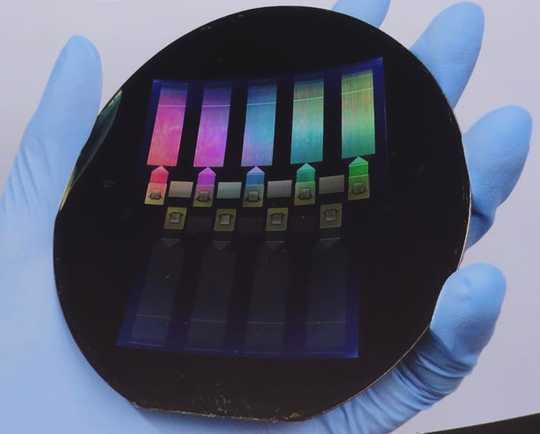
whiteMocca/Shutterstock, CC BY-SA
Cyborgs are no longer science fiction. The field of brain-machine interfaces (BMI) – which use electrodes, often implanted into the brain, to translate neuronal information into commands capable of controlling external systems such as a computer or robotic arm – have actually been around for some time. Entrepreneur Elon Musk’s company, Neuralink, is aiming to test their BMI systems on a human patient by the end of 2020.
In the long term, BMI devices may help monitor and treat symptoms of neurological disorders and control artificial limbs. But they could also provide a blueprint to design artificial intelligence and even enable direct brain-to-brain communication. However, for the time being, the main challenge is to develop BMIs that avoid damaging brain tissue and cells during implantation and operation.
BMIs have been around for over a decade, helping people who have lost the ability to control their limbs, for example. However, conventional implants – often made of silicon – are orders of magnitude stiffer than the actual brain tissue, which leads to unstable recordings and damage to surrounding brain tissue.
They can also lead to an immune response in which the brain rejects the implant. This is because our human brain is like a guarded fortress, and the neuroimmune system -– like soldiers in this closed fortress – will protect neurons (brain cells) from intruders, such as pathogens or BMI.
Flexible devices
To avoid damage and immune responses, researchers are increasingly focusing on the development of so-called “flexible BMI”. These are much softer than silicon implants and similar to actual brain tissue.
 A wafer of tens of thousands of flexible electrodes, each much smaller than a hair. Steve Jurvetson/Flickr, CC BY-SA
A wafer of tens of thousands of flexible electrodes, each much smaller than a hair. Steve Jurvetson/Flickr, CC BY-SA
For example, Neuralink made its first designed flexible “threads” and inserter – tiny, thread-like probes, which are much more flexible than previous implants – to link a human brain directly to a computer. These were designed to minimise the chance of the brain’s immune response rejecting the electrodes after insertion during brain surgery.
{vembed Y=kPGa_FuGPIc}
Meanwhile, researchers from Lieber group at Harvard University recently designed a mini mesh probe that looks so much like real neurons that the brain cannot identify the impostors. These bio-inspired electronics consist of platinum electrodes and ultra-thin gold wires encapsulated by a polymer with size and flexibility similar to neuron cell bodies and neural nerve fibres.
Research on rodents has shown that such neuron-like probes do not elicit an immune response when inserted into the brain. They are able to monitor both the function and migration of neurons.
Moving into cells
Most BMIs used today pick up electrical brain signals that are leaked outside of the neurons. If we think of the neural signal like a sound generated inside a room, the current way of recording is therefore to listen to the sound outside the room. Unfortunately, the intensity of the signal is greatly reduced by the filtering effect of the wall – the neuron membranes.
To achieve the most accurate functional readings in order to create greater control of for example artificial limbs, electronic recording devices need to gain direct access to the interior of neurons. The most widely used conventional method for this intracellular recording is the “patch clamp electrode”: a hollow glass tube filled with an electrolyte solution and a recording electrode brought into contact with the membrane of an isolated cell. But a micrometre-wide tip causes irreversible damage to the cells. What’s more, it can only record a few cells at a time.
To address these issues, we recently developed a hairpin-like 3D nanowire transistor array and used it to read intracellular electrical activities from multiple neurons. Importantly, we were able to do this without any identifiable cellular damage. Our nanowires are extremely thin and flexible, and easily bended into the hairpin shape – the transistors are only about 15x15x50 nanometres. If a neuron were the size of a room, these transistors would be about the size of a door lock.
Coated with a substance that mimics the feel of a cell membrane, these ultra small, flexible, nanowire probes can cross the cell membranes with minimal effort. And they can record intracellular chatter with the same level of precision as their biggest competitor: patch clamp electrodes.
Clearly these advances are important steps towards accurate and safe BMIs that will be necessary if we are ever to achieve complex tasks like brain-to-brain-communication.
It may sound a bit scary but, ultimately, if our medical professionals are to continue to understand our bodies better and help us treat diseases and live longer, it is important that we continue to push the boundaries of modern science to give them the best possible tools to do their jobs. For this to be possible, a minimally invasive intersection between humans and machines is inevitable.![]()
About The Author
Yunlong Zhao, Lecturer in Energy Storage and Bioelectronics, University of Surrey
This article is republished from The Conversation under a Creative Commons license. Read the original article.























